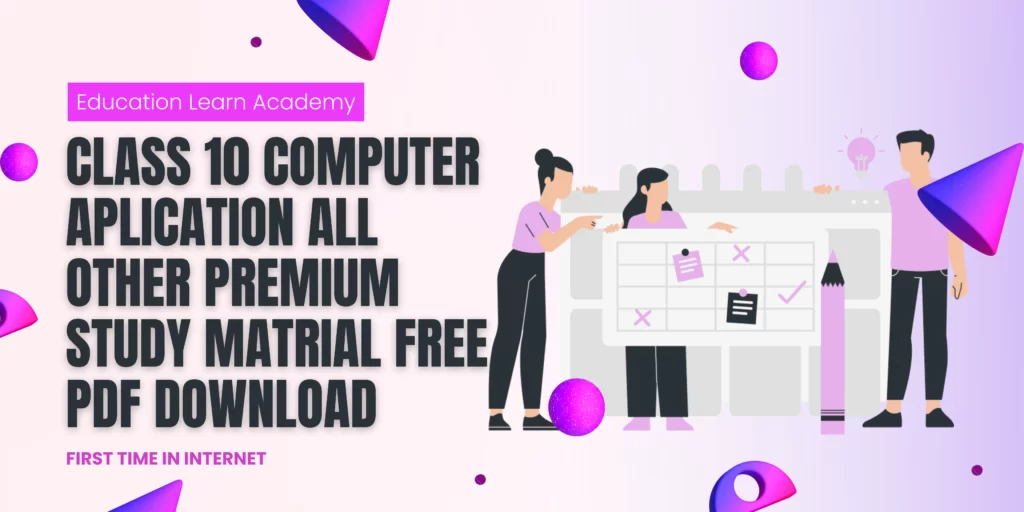
CLASS 10 COMPUTER APLICATION ALL OTHER PREMIUM STUDY MATRIAL FREE PDF: The Class 10 Computer Application curriculum is designed to provide students with a basic understanding of computer programming and its applications.
The syllabus covers topics such as programming concepts, data types, control structures, functions, arrays, files, and database management systems. Students are also introduced to programming languages such as Python and SQL.

Class 10 is a helpful self-study guide that covers the important topics for Computer Applications exams. It is written in an easy-to-understand way and follows the latest CBSE syllabus. The book has 9 chapters that explain the concepts with examples and practice questions. It also includes new pattern objective questions and chapter-wise practice exercises. There are sample papers for students to practice and revise before their exams. It is a useful resource for students to prepare well for their exams and get higher grades.
𝗖𝗢𝗡𝗧𝗔𝗜𝗡𝗦 𝗡𝗢𝗧𝗘𝗦
- 𝗠𝗔𝗡𝗬 𝗢𝗧𝗛𝗘𝗥 𝗣𝗥𝗘𝗠𝗜𝗨𝗠 𝗠𝗔𝗧𝗘𝗥𝗜𝗔𝗟𝗦
- 𝗖𝗕𝗦𝗘 𝗞𝗩𝗦 𝗪𝗢𝗥𝗞𝗦𝗛𝗘𝗘𝗧𝗦
- 𝗣𝗥𝗘𝗩𝗜𝗢𝗨𝗦 𝗬𝗘𝗔𝗥 𝗤𝗨𝗘𝗦𝗧𝗜𝗢𝗡𝗦
- 𝗦𝗔𝗠𝗣𝗟𝗘 𝗣𝗔𝗣𝗘𝗥𝗦 ( 𝗧𝗘𝗥𝗠 𝟮 𝗜𝗡𝗖𝗟𝗨𝗗𝗘𝗗 𝗔𝗟𝗦𝗢 𝗜𝗡𝗖𝗟𝗨𝗗𝗘𝗗)
In addition to the curriculum, the Class 10 examination is also an essential aspect of the academic journey. The examination assesses the student’s knowledge, understanding, and application of the concepts learned in class. It also provides a platform for students to showcase their skills and abilities, and to earn recognition for their hard work and dedication.
| Units | Unit Name | Marks |
|---|---|---|
| I | Networking | 20 |
| II | HTML | 25 |
| III | Cyber Ethics | 10 |
| IV | Scratch/ Python | – |
| Practicals | 50 | |
| TOTAL | 100 |
CBSE Class 10 Computer Applications Syllabus 2023
CBSE Class 10 students with Computer Applications as one of their subjects can download the CBSE Class 10 Computer Applications Revised Syllabus for the current academic session. This syllabus is helpful to know the chapter-wise content to be prepared in the session 2022-2023 along with the details of practical work. It also mentions the unit-wise weightage for the annual assessment.
LESSONS
Unit 1: Networking
- Internet: World Wide Web, web servers, web clients, web sites, web pages, web browsers, blogs, news groups, HTML, web address, e-mail address, downloading and uploading files from a remote site. Internet protocols: TCP/IP, SMTP, POP3, HTTP, HTTPS. Remote login and file transfer protocols: SSH, SFTP, FTP, SCP, TELNET, SMTP, TCP/IP.
- Services available on the internet: information retrieval, locating sites using search engines and finding people on the net;
- Web services: chat, email, video conferencing, e-Learning, e-Banking, eShopping, e-Reservation, e-Governance, e-Groups, social networking.
- Mobile technologies: SMS, MMS, 3G, 4G.
Unit 2: HTML
- Introduction to web page designing using HTML: create and save an HTML document, access a web page using a web browser.
- HTML tags: html, head, title, body, (attributes: text, background, bgcolor, link, vlink, alink), br (break), hr(horizontal rule), inserting comments, h1..h6 (heading), p (paragraph), b (bold), i (italics), u (underline), ul (unordered list), ol (ordered list), and li (list item). Description lists: dl, dt and dd. Attributes of ol (start, type), ul (type).
- Font tags (attributes: face, size, color).
- Insert images: img (attributes: src, width, height, alt), sup (super script), sub (subscript).
- HTML Forms: Textbox, radio buttons, checkbox, password, list, combobox.
- Embed audio and video in a HTML page.
- Create a table using the tags: table, tr, th, td, rowspan, colspan
- Links: significance of linking, anchor element (attributes: href, mailto), targets.
- Cascading style sheets: colour, background-colour, border-style, margin, height, width, outline, font (family, style, size), align, float.
Unit 3: Cyber ethics
- Netiquettes.
- Software licenses and the open source software movement.
- Intellectual property rights, plagiarism and digital property rights.
- Freedom of information and the digital divide.
- E-commerce: Privacy, fraud, secure data transmission.
4. Lab Exercises
- Create static web pages.
- Use style sheets to enforce a format in an HTML page (CSS).
- Embed pictures, audio and videos in an HTML page.
- Add tables and frames in an HTML page.
- Decorate web pages using graphical elements.
- Create a website using several webpages. Students may use any open source or proprietary tool.
- Work with HTML forms: text box, radio buttons, checkbox, password, list, combo box.
- Write a blog using HTML pages discussing viruses, malware, spam and antiviruses
- Create a web page discussing plagiarism. List some reported cases of plagiarism and the consequent punishment meted out. Explain the nature of the punishment in different countries as per their IP laws.
CLASS 10 COMPUTER APLICATION ALL OTHER PDF DOWNLOAD
Recent Posts
- (PDF) Class 10 Together with Science Question Bank Free Pdf Download
- New Motion Institute Test Series For NEET PDF Download
- Together with English Class 10 Question Bank Free Pdf Download (Based On Latest Syllabus) 2023
- Class 10 English Literature Handwritten Booklet Free Pdf Download 2023
- Alpha Assertion Reason Booklet Free Pdf Download 2023
- CBSE Class 10 Hindi-A 2023 Term-2 : Topic-Wise Question Bank With Solution
conclusion
the Class 10 curriculum is a well-rounded educational program that prepares students for the challenges of the future. It equips them with the necessary knowledge, skills, and attitudes to lead a successful and fulfilling life. As students embark on this journey, they must embrace the curriculum with an open mind and a willingness to learn and apply their knowledge in real-life situations.








